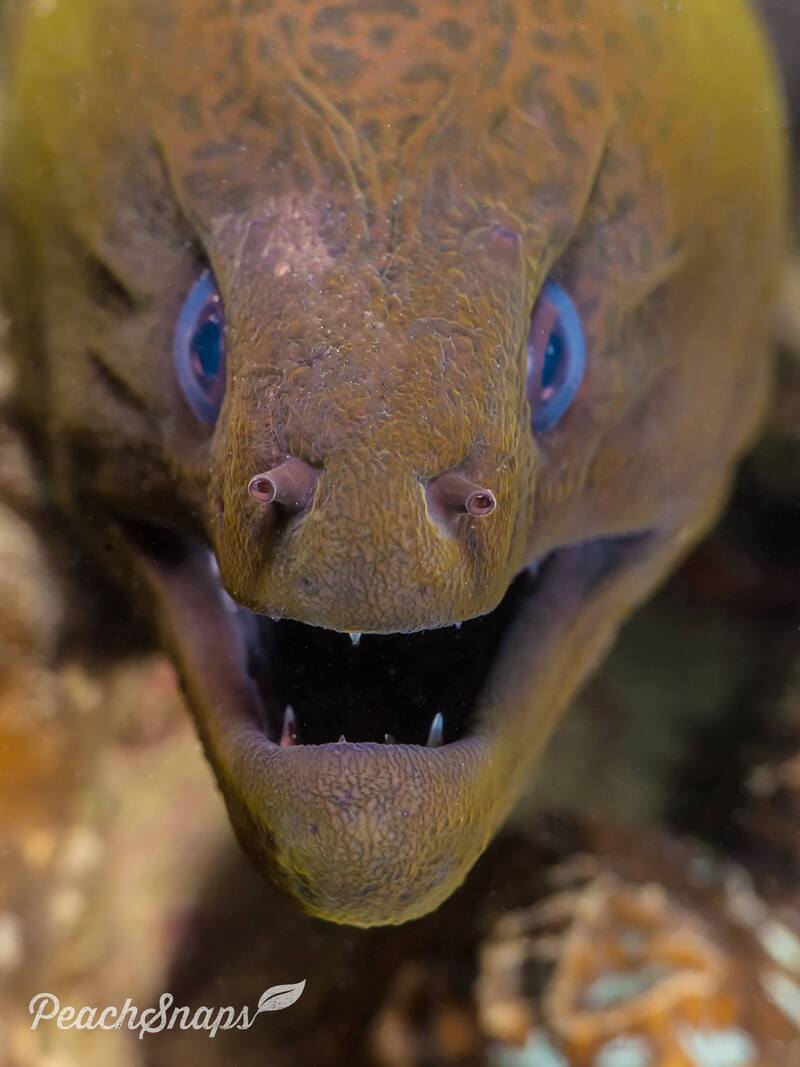The giant moray eel (Gymnothorax javanicus) is one of the largest and most intimidating eels in the ocean, often lurking in the crevices of coral reefs, waiting to ambush prey. Known for its snake-like body and sharp, protruding teeth, the giant moray is both fascinating and formidable. These nocturnal hunters are a favorite subject for divers and underwater photographers, despite their fearsome appearance. Let’s explore some interesting facts, behaviors, and stories about the giant moray eel, along with tips on how to observe them safely.

Appearance and Habitat
The giant moray eel can grow up to 9.8 feet (3 meters) in length and weigh as much as 66 pounds (30 kg), making it one of the largest eel species in the world. Its body is elongated and muscular, covered in a slimy, smooth skin that helps it navigate the narrow crevices of coral reefs. Typically, the giant moray has a dark brown or olive coloration with irregular black spots, which helps it blend into its environment.
This species is native to the Indo-Pacific region, particularly around coral reefs, rocky outcrops, and lagoons. During the day, they hide in small caves or crevices, with only their head protruding, making them difficult to spot. At night, they become active hunters, venturing out to feed.
Behavior and Diet
Giant moray eels are carnivorous, feeding primarily on fish, crustaceans, and even octopuses. They are ambush predators, using their excellent sense of smell to detect prey before launching a surprise attack. Interestingly, moray eels have a second set of jaws, called “pharyngeal jaws,” which extend from their throat to help pull prey into their mouths once captured.
Despite their fearsome reputation, giant moray eels are generally non-aggressive towards humans unless provoked. They are known to be curious creatures, sometimes poking their heads out of their hiding spots to observe divers passing by. However, getting too close or cornering one can lead to a defensive bite, which is why divers are advised to keep a respectful distance.
Funny Encounters with the Giant Moray
Divers often share amusing stories about their encounters with giant moray eels. One such tale involves a diver who mistook a moray eel’s head sticking out of a hole for a piece of coral. He reached out to touch it, only to have the eel slowly emerge, opening its toothy mouth in a yawn-like stretch. The diver, startled but unharmed, realized his mistake and quickly backed away, leaving the eel to continue its relaxing day in peace.
In another funny story, a group of divers spotted a giant moray during a night dive, its head sticking out of a crevice. To their surprise, the eel seemed more interested in following their dive lights rather than hiding. As the divers swam along, the moray slithered from one light to another, seemingly curious about the sudden glow in its usually dark world.
Are Giant Moray Eels Dangerous?
Although they may look intimidating, giant moray eels are generally shy and prefer to avoid confrontation. They are not aggressive unless they feel threatened or provoked. However, they have powerful bites, and their sharp teeth can cause serious injury, so it’s best to admire them from a distance. Most incidents with moray eels occur when divers accidentally get too close or try to feed them.
A key safety tip for divers is to avoid putting hands near crevices or caves where moray eels might be hiding, as they can mistake fingers for prey. Also, shiny objects like jewelry should be avoided, as they can catch the attention of these curious creatures.
Conservation and Role in the Ecosystem
As apex predators, giant moray eels play an essential role in coral reef ecosystems by keeping fish populations in check and helping maintain the balance of marine life. While they are not currently endangered, moray eels face threats from overfishing, habitat destruction, and the decline of coral reefs. Protecting their natural habitats is crucial to preserving these magnificent creatures.
Frequently Asked Questions About Giant Moray Eels
What is a Giant Moray Eel?
The Giant Moray Eel (Gymnothorax javanicus) is the largest moray eel species, reaching lengths up to 3 meters. Recognized by its mottled brown coloration and robust body, it inhabits coral reefs across the Indo-Pacific region, often residing in crevices during the day and hunting at night.
Where are Giant Moray Eels commonly found?
Giant Moray Eels are widespread throughout the Indo-Pacific, from the Red Sea and East Africa to Hawaii and the Marquesas Islands. They prefer sheltered reef environments, hiding among rocks and coral formations during daylight hours.
What do Giant Moray Eels eat?
As nocturnal predators, Giant Moray Eels feed on fish, octopuses, and crustaceans. They use their keen sense of smell to locate prey and possess a second set of jaws, called pharyngeal jaws, to grasp and swallow their catch efficiently.
Are Giant Moray Eels dangerous to humans?
While generally not aggressive, Giant Moray Eels can bite if provoked or threatened. Divers should avoid placing hands near crevices or attempting to feed them, as bites can cause serious injury due to their sharp teeth and strong jaws.
Why are Giant Moray Eels important to marine ecosystems?
Giant Moray Eels play a vital role in maintaining the balance of reef ecosystems by controlling populations of smaller fish and invertebrates. Their presence indicates a healthy reef environment and contributes to biodiversity.
Final Thoughts
The giant moray eel is an awe-inspiring predator that adds to the mystique of the underwater world. Whether you’re a diver, snorkeler, or just fascinated by marine life, encountering a giant moray eel is a memorable experience. Their powerful presence and unique behavior make them one of the most intriguing creatures of the coral reef ecosystem. While they might look intimidating, these eels are generally peaceful unless provoked, making them a wonder to observe in their natural habitat.
Check out our next article about: Pink Spotted Shrimp Goby


Leave a Reply